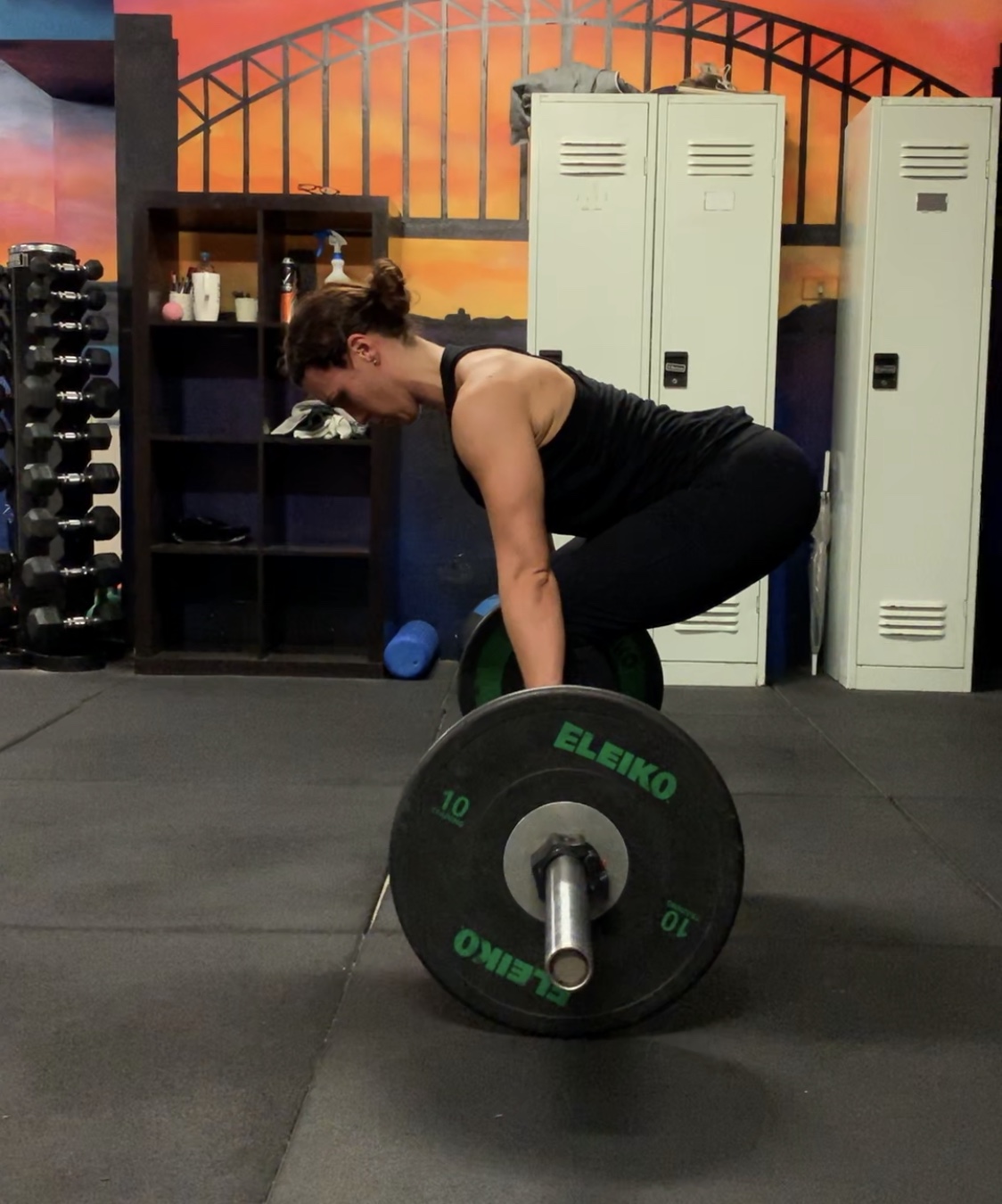So, where did that year go? Time has flown by and so much has happened over the past 365 days.
I'm writing this email to re-cap the past 12 months and showcase some of the amazing results my clients have achieved.
Thanks for reading - I hope you have a fantastic holiday season & a very Happy New Year.
-Paul
Client Testimonial: Roxy
“I would call Paul a life and game changer. When I started training with Paul, I was a broken women. I hadn't trained properly for 2months due to injury and I was very deflated.
I know what I am capable of but I needed that coach who was going to bring me back to basics, be precise in teaching me the technique and get me on injury free road and feeling strong again.
In regards to training programs, Paul has hit every nail on the head with program design. It's kept me interested, made me challenge myself and most importantly injury free and structurally strong again. Paul is a master at what he does and so humble at the same time.
I’ve learnt so much from him and he's always there 24/7 to support.
Bring on next year Paul, where a long dream of mine is to get on stage. Well that will finally come true. I will be ready and that's because of with your motivation, guidance and wealth of knowledge!
I can't thank you enough Paul!
I know this will be hard for you to take this feedback but you honestly have been awesome!!
Best investment I have made to feeling human again”
Struggling to Lose Weight? Hit a Plateau you Cannot Seem to Break Through? Maybe You Need..... A Diet Break.
As I explained in an earlier blog post, the human metabolism is highly plastic, and prone to both up- and down-regulation. In most cases, down-regulation of the metabolism will occur as a result of chronic dieting. Diet breaks can be used as a tool to combat some of this metabolic down-regulation that results from eating in a calorie deficit.
The goal of this article to give you a clearer understanding of: -
What a diet break is
What a diet break involves
Who should use diet breaks
How often you should utilise a diet break
4 Fat Loss Mistakes You Need To Stop Making
Fat loss is simple. Not easy. Simple.
For the most part, we all have a pretty good understanding of what we need to focus on in order to make progress (or at least if you have been following me for some time you SHOULD have!).
However, despite the simplicity of knowing you need to be in a calorie deficit and eating enough protein, it often isn’t easy. Below are 4 of the most common pitfalls I see with clients I have dealt with over the past 10 years as a coach. I’m sure there are at least a couple you can relate to….
Metabolism Myths
I very often get asked questions relating to metabolism and how it is affected by diet and exercise. There seems to be a great deal of confusion about metabolism, so I hope to clarify some of the main questions clients come to me with.
So firstly, let’s address the question at the forefront of your mind: ‘What is your ‘metabolism’?
Your metabolism is the sum of all of the chemical reactions taking place within your body. Your metabolism can be viewed as your ‘internal furnace’. Your metabolism is comprised of 3 main components: -
Basal Metabolic Rate (BMR) - The amount of energy required to maintain basic life processes. In sedentary populations, BMR accounts for around 60% of total daily energy expenditure (see diagram below).
Thermic Effect of Food (TEF) - The amount of calories you burn digesting and absorbing your food.
Activity Thermogenesis - Can be split into Non-Exercise Activity Thermogenesis (NEAT) and exercise-related activity. NEAT refers to any energy expenditure of daily living that is not formal activity, such as walking to work, taking stairs, fidgeting, shopping etc.
"Think Big and Follow Your Dreams": Matteo's Story
Would You Like More Energy, Confidence, Success? Read on to learn how....
Question: If you were to sum up the benefits of losing weight/body fat and training in one sentence, what would you say?
This was the exact question I posed to my clients this week.
All answers can be found below.
Some consistent themes emerged, namely...
Improved confidence
Feeling Happier/Better about yourself
Improved Mindset
Improved performance
Success in other areas of life
Read on for full answers and transformation pictures....
Real Life Tips to Help you Win at Life
The nature of my job means I have the great pleasure of being in regular contact with a lot of successful people.
Over the past 10 years I have trained accountants, lawyers, business owners, bankers, real estate agents, recruiters, architects, property developers, actors, writers, doctors, dentists and almost every occupation in between.
I would like to think many of these clients learnt something from their time working with me (hopefully!). However, the truth is that I probably learned more from them! Spending time with successful people is one of the best ways to improve your standing in life. After all, as the saying goes "you are the average of the 5 people you spend most time with".
So here is a compilation of some of the most sage advice my clients have found has worked for them: -
Dieting - How Not to Suck at it!
We have a problem. 45 million Americans go on a diet each year.
Yet rates of overweight and obesity continue to soar.
60% of Australian adults are overweight or obese. There are more adults that are overweight and obese than those who are not.
This article is going to take a look at how to approach dieting differently, and hopefully be more successful at it in the long term.
You're Gona Reap What You Sow
"Give me six hours to chop down a tree and I will spend the first four sharpening the axe" (Abraham Lincoln)
Some people seem to believe that achieving body composition results (i.e. losing fat or gaining muscle) and achieving good health are mutually exclusive.
Let me tell you that they are not.
Actually, the healthier an individual is, the better (and faster) the body composition results will come.
Let that sink in before you start a crash diet to 'dramatically drop weight'.
Health must be your number 1 priority if fat loss is your goal.
The metaphor of a tree is a useful one here. Without looking after the roots, the tree will eventually die. It won't happen straight away, and the symptoms will be visible at the edges, leaves turning brown and dying, before eventually branches start to fall off. Humans, like trees, need to look after the roots and the 'soil' they live in.
Which brings me back to the first quote. Are you creating the right conditions for your body to function optimally?
Advanced Fat Loss Workshop - Top 5 Take Home Points....
On July 22nd Brad Soper (https://www.schoolofstrong.com.au) and myself hosted our Advanced Fat Loss Workshop,
Below are 5 of the key take home points from the workshop…
Client Testimonial: James
I started training with Paul because I was confused. I’d been trying to get fitter and leaner but without any real plan and running myself into the ground in the process.
Working with an online PT wasn’t something I’d really considered before but I’d seen Paul’s social media and I was soon blown away by the results first hand. Immediately Paul added discipline and structure to my training. My body shape and muscle strength is now the best it’s been in 15 years.
Paul’s staged but constantly challenging approach and willingness to explain his reasoning mean that improvements aren’t just limited to the gym but translate into lifestyle choices too. I couldn’t recommend Paul enough.
The Physique Wise Guide to... Tempo
Tempo = The speed at which you perform an exercise - sometimes referred to as 'cadence'
Tempo is usually expressed as 4 numbers - For example, “4 0 1 0”, or "20X0"
The First Number: The Eccentric Lifting Speed: The eccentric portion of a lift relates to the phase when the working muscle(s) are lengthening under tension. For example, the quadriceps (thigh muscles) on the downward phase of a squat, leg extension, leg press etc. The first number is usually the biggest number, as the eccentric portion of the lift is usually controlled.
The Second Number: Pause in the Stretched Position: If the number is a zero then this would mean that there is no pause after the eccentric phase of the lift and you go straight into the concentric phase of the lift. A '1' would denote a 1 second pause in the stretched position.
The Third Number: The Concentric Lifting Speed: The concentric portion of the lift relates to the phase when the working muscle(s) are shortening under tension, For example, the quadriceps on the upward phase of a squat, leg extensions, leg press etc. An ‘X’ during the concentric phase relates to the lift being performed ‘explosively’.
The Fourth Number: Pause in the Shortened Position: If the number is a zero then this would mean that there is no pause in the shortened position and that you would go straight into the eccentric portion of the lift.
So a tempo with the numbers '3111' would mean a 3 second eccentric phase, a 1 second pause in the stretched position, a 1 second concentric portion, and a 1 second pause in the shortened position.
What are the benefits to using tempo in your training?
- Slower lifting tempos can be extremely useful for beginners who need to learn motor control, create mind-muscle connection and learn correct movement patterns
- Can be useful for experienced lifters as means of overloading a movement
- Using tempo standardises a lift so you can assess whether you are making strength improvements or simply just moving the weight faster each week.
- Slowing down the exercises means less load can be used, reducing the likelihood of injury occurring
- Using pauses in either the stretched or shortened position (or both) can vastly improve the effectiveness of certain exercises
- Using specific tempos can ensure you are utilising the correct energy system you are wishing to target
What are some of the disadvantages of slowing down the lifting speed?
- Slower lifts create less mechanical tension on the muscle
- Using faster tempos can result in greater overall work - “Lifting with short eccentric phases and no bottom rest produced greater repetitions and Power Output, and therefore, total work volume than repetition tempos with 4-second eccentric phases or 3-second bottom rest intervals” (King, et al, 2011)
- You can use a greater load on the bar with faster tempos
- You can utilise the stretch-shortening cycle by using a faster lifting speed
- You can develop more strength and power utilising a faster lifting speed
- Greater recruitment of fast twitch muscle fibres when lifting faster
So as a general rule of thumb, the newer to training a client is, the more I will utilise slower lifting tempos. This is to ensure that: -
1) Chance of injury is minimised
2) The emphasis is on controlling the movement and learning correct movement patterns
3) To establish a mind-muscle connection - this is much easier with slower lifting speeds
4) To learn how to recruit certain muscles. For example, it might be advantageous to pause at the top of a hip bridge to maximally contract the glutes and 'feel' them working
Only once you have mastered an exercise with a slow tempo should you try to lift faster.
Whether lifting with a slow tempo or a fast tempo the goal should always be to lift with intent & completely focus on what you are doing.
Rachel's Story
I am eating more than I ever thought I could, while being as lean as I’ve ever been (minus eating disorder years). I can easily say that Paul changed my entire life. Paul taught me how to eat smart in social settings, and gave me the tools to even roughly maintain my body fat percentage on vacation. The greatest lesson I have learned so far is that eating healthy doesn’t have to suck, you don’t have to starve yourself to lose fat, and EVERYTHING IN MODERATION.
Client Testimonial: Sarah
I would recommend Paul to anyone looking to put in the work, understand the fitness lifestyle and what it really takes to get to the next level. At the end of the day, I feel stronger than I ever have before, healthier (thanks to his insistence on more carbs - not in the form of bubbles- and calories in general) and more “defined” than I ever have before. Had you told me 5 years ago that deadlifting 50kg was possible - I’d say no way! Thanks Paul, your commitment to your work, your passion for what you do and your friendly and good hearted nature has made what could have been a really tough 5 months fly by!

















